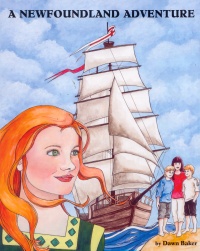| ________________
CM . . .
. Volume XXI Number 21. . . .February 6, 2015

 |
A Newfoundland Adventure.
Dawn Baker.
St. John’s, NL: Flanker Press/Pennywell Books, 2014.
32 pp., pbk. & pdf, $14.95 (pbk.).
ISBN 978-1-77117-353-7 (pbk.), ISBN 978-1-77117-354-4 (pdf).
Grades 2-5 / Ages 7-10.
Review by Rebecca King.
* /4
|
| |
|

excerpt:
After this tale of high seas adventure was finished, the weary travellers left with the Newfoundland livyers and plans were made to return to the ship the next morning.
This seemed to be a good time for the “Three Musketeers” to begin to make their way home, as well. The trio shook the sand from their clothes and went back to the tunnel. They hadn't gone far, so it was pretty easy to find.
It's summer in Newfoundland. David is visiting his cousins, Richard and Heather, in Little Heart's Ease. After breakfast, the "trio", who think of themselves as the "Three Musketeers" because they are "always ready for adventure", head to the beach. After some beachcombing, they discover a cave they have never seen before. Though the cave is scary, they begin to explore it and discover light at the end. It is, in fact, a tunnel leading to a different beach with no sounds of their busy community. A full-rigged sailing ship sails into sight, and there are people who appear to be in costume on the beach. Thinking this is perhaps a filming location, the children call and wave, but the people cannot seem to see or hear them. The children draw closer and watch and listen as the arrival of the privateer Peter Easton and the legendary Irish princess Sheila NaGeira unfolds before them. The children return through the tunnel but are unable to find it the next day. Heather looks up these historical characters on her tablet.
 Author Dawn Baker's goal in writing A Newfoundland Adventure seems to be to create excitement about Newfoundland history in her readers. To achieve this goal, she has chosen to have three children travel through a tunnel to the seventeenth century and witness Peter Easton, an actual historical character, and Sheila NaGeira, a recently legendary character (she doesn't appear in Newfoundland lore until the early 1900's), arrive at Harbour Grace, Newfoundland. Twenty-four pages are allotted to the story of this picture book. The author divides the pages evenly between the contemporary story and the historical story. Unfortunately, by dividing the story into two halves, neither half can truly build the momentum to make the story exciting and adventurous. The three children get up, have breakfast, do some beachcombing, see a cave that turns into a tunnel, see some weird people, and with no difficulty find their way home. It is the historical characters who truly have an adventure. Peter Easton is a privateer, commissioned by Queen Elizabeth I, but we don't know his reasons for choosing that life or much about his experiences in that role. The legendary Sheila NaGeira is travelling to France (though we aren't told why) by ship when it is attacked by Dutch pirates. There is some description of her feelings as the pirates attack. Author Dawn Baker's goal in writing A Newfoundland Adventure seems to be to create excitement about Newfoundland history in her readers. To achieve this goal, she has chosen to have three children travel through a tunnel to the seventeenth century and witness Peter Easton, an actual historical character, and Sheila NaGeira, a recently legendary character (she doesn't appear in Newfoundland lore until the early 1900's), arrive at Harbour Grace, Newfoundland. Twenty-four pages are allotted to the story of this picture book. The author divides the pages evenly between the contemporary story and the historical story. Unfortunately, by dividing the story into two halves, neither half can truly build the momentum to make the story exciting and adventurous. The three children get up, have breakfast, do some beachcombing, see a cave that turns into a tunnel, see some weird people, and with no difficulty find their way home. It is the historical characters who truly have an adventure. Peter Easton is a privateer, commissioned by Queen Elizabeth I, but we don't know his reasons for choosing that life or much about his experiences in that role. The legendary Sheila NaGeira is travelling to France (though we aren't told why) by ship when it is attacked by Dutch pirates. There is some description of her feelings as the pirates attack.
Sheila hid in her cabin and prayed for the ship and its crew as the swords clashed outside her door. The lovely Irish princess held her breath as things began to quiet. The door to her cabin flew open and Sheila found herself looking into the face of a stern stranger!
Sheila is taken aboard the Dutch ship with other passengers, and their ship is burned. Then Peter Easton's ship, the Happy Adventure, overtakes the Dutch ship, and Sheila is rescued. But the Happy Adventure is headed to Newfoundland. Once again, we know little of her feelings, though she marries Lieutenant Gilbert Pike. We are not even told if they stay in Newfoundland.
In my judgement, the story would have held more excitement if it had fully explored Sheila's experiences and emotions as well as Peter Easton's motives and experiences. The characters as presented are very flat. If the whole book were dedicated to these characters, their adventure could be more developed. If the contemporary story were retained, perhaps having the children interacting with the historical characters or observing a more dynamic event than people landing on the beach and overhearing a conversation would make that part more engaging.
The illustrations, though colourful and pretty, are stiff and flat. The style seems immature, as if drawn by a teenaged girl. There is no sense that the illustrator has a sense of the body mechanics under the clothes. Figures and objects tend to look as if they are floating in space. The composition of each frame is not used effectively to create dynamic movement within that frame.
I was completely unentranced by this "adventure".
Not Recommended
Rebecca King retired in July 2014 with 25 years of service as a Library Support Specialist with the Halifax Regional School Board.

To comment
on this title or this review, send mail to cm@umanitoba.ca.
Copyright © the Manitoba Library Association. Reproduction for personal
use is permitted only if this copyright notice is maintained. Any
other reproduction is prohibited without permission.
Next Review| Table of Contents For This Issue - February 6, 2015.
CM Home | Back Issues
| Search
| CM Archive
| Profiles Archive
|

 Author Dawn Baker's goal in writing A Newfoundland Adventure seems to be to create excitement about Newfoundland history in her readers. To achieve this goal, she has chosen to have three children travel through a tunnel to the seventeenth century and witness Peter Easton, an actual historical character, and Sheila NaGeira, a recently legendary character (she doesn't appear in Newfoundland lore until the early 1900's), arrive at Harbour Grace, Newfoundland. Twenty-four pages are allotted to the story of this picture book. The author divides the pages evenly between the contemporary story and the historical story. Unfortunately, by dividing the story into two halves, neither half can truly build the momentum to make the story exciting and adventurous. The three children get up, have breakfast, do some beachcombing, see a cave that turns into a tunnel, see some weird people, and with no difficulty find their way home. It is the historical characters who truly have an adventure. Peter Easton is a privateer, commissioned by Queen Elizabeth I, but we don't know his reasons for choosing that life or much about his experiences in that role. The legendary Sheila NaGeira is travelling to France (though we aren't told why) by ship when it is attacked by Dutch pirates. There is some description of her feelings as the pirates attack.
Author Dawn Baker's goal in writing A Newfoundland Adventure seems to be to create excitement about Newfoundland history in her readers. To achieve this goal, she has chosen to have three children travel through a tunnel to the seventeenth century and witness Peter Easton, an actual historical character, and Sheila NaGeira, a recently legendary character (she doesn't appear in Newfoundland lore until the early 1900's), arrive at Harbour Grace, Newfoundland. Twenty-four pages are allotted to the story of this picture book. The author divides the pages evenly between the contemporary story and the historical story. Unfortunately, by dividing the story into two halves, neither half can truly build the momentum to make the story exciting and adventurous. The three children get up, have breakfast, do some beachcombing, see a cave that turns into a tunnel, see some weird people, and with no difficulty find their way home. It is the historical characters who truly have an adventure. Peter Easton is a privateer, commissioned by Queen Elizabeth I, but we don't know his reasons for choosing that life or much about his experiences in that role. The legendary Sheila NaGeira is travelling to France (though we aren't told why) by ship when it is attacked by Dutch pirates. There is some description of her feelings as the pirates attack.